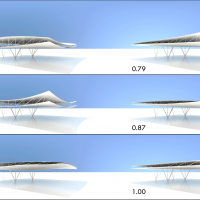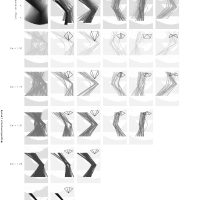Tag: visualization
-
 Mohamed Ismail Presents at ACSA 20182018-03-17, Tags: conceptual-design conceptual-structural-design constructabililty design-tool shell-structures structural-optimization visualization
Mohamed Ismail Presents at ACSA 20182018-03-17, Tags: conceptual-design conceptual-structural-design constructabililty design-tool shell-structures structural-optimization visualizationMohamed presented his paper entitled "Resistance Through Form: Synthesis Structures in the Design of a Residential Architecture for Khartoum, Sudan" at the Association of Collegiate Schools of Architecture's (ACSA) 106th Annual Meeting in Denver, Colorado, on March 17th, 2018. He presented his paper in the session "Architecture of the other 99%? – Power, Economy, and the Dilemma of History", and then joined a panel discussion moderated by Professor Ole Fischer of the University of Utah.
-
 Digital brainstorming: New computational tools for creative data-driven designCaitlin Mueller, Nathan Brown, and Renaud Danhaive, ABX 2015: Conference for the Boston Society of Architects, 2015
Digital brainstorming: New computational tools for creative data-driven designCaitlin Mueller, Nathan Brown, and Renaud Danhaive, ABX 2015: Conference for the Boston Society of Architects, 2015This session focuses on tools that link conceptual design decisions in architecture to quantitative and qualitiative performance metrics, such as structural material volume, energy consumption, daylighting quality, and formal and spatial qualities. Developed by the Digital Structures research group at MIT, these tools emphasize design over analysis, aiming to help designers explore a wide range of diverse, surprising, and high-performing alternatives for conceptual design problems. Participants will learn strategies for using the tools in their own practices to navigate conceptual building design problems in a flexible yet data-driven way.
-
 High-dimensional design space visualization for conceptual structural designCaitlin Mueller, MIT SM Thesis, 2014
High-dimensional design space visualization for conceptual structural designCaitlin Mueller, MIT SM Thesis, 2014This thesis focuses on visualizing high-dimensional design spaces for early-stage design problems in structural engineering and related disciplines. The design space, which is defined as the n + 1-dimensional surface that relates n design variables to a performance metric, contains all possible solutions to a formulated design problem. Graphical views of the design space are highly useful for designers because they organize a wide range of design possibilities in a compact, intuitive, and logical manner, illuminating global patterns, variable behaviors and relationships, and the nature of paths taken during iterative design processes. Design problems with two or fewer variables can easily be visualized in Euclidian space, through a curve or surface, but high-dimensional problems are difficult to display graphically. This is the key challenge addressed in this thesis. The thesis includes a critical review of existing methods for high-dimensional design space visualization, highlighting the unmet needs across a range of approaches. In response to these needs, the thesis makes a key contribution in the form of a new design space visualization method, called isoperforming parallel coordinate clusters (IPC clusters), that overcomes the issues of previous techniques. The IPC cluster approach is demonstrated on several conceptual structural design problems, and its application in optimization, directed exploration, and related design strategies is illustrated. Finally, the thesis concludes with a discussion of applications, impact, and future research directions.


